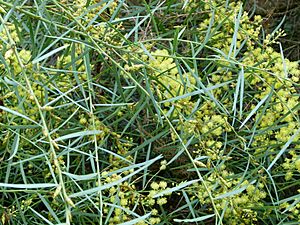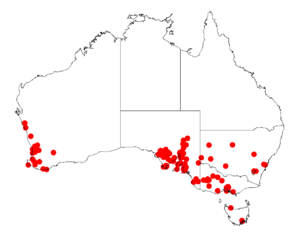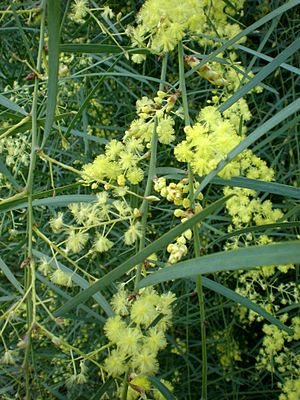Flinders Range wattle facts for kids
Quick facts for kids Flinders Range wattle |
|
|---|---|
 |
|
| Scientific classification | |
| Genus: |
Acacia
|
| Species: |
iteaphylla
|
 |
|
| Occurrence data from AVH | |
The Acacia iteaphylla, also known as the Flinders Range wattle, Port Lincoln wattle, winter wattle, or willow-leaved wattle, is a beautiful shrub. It belongs to a large group of plants called Acacia and is native to South Australia.
Contents
What Does the Flinders Range Wattle Look Like?
This lovely shrub often has branches that hang down, making it look like it's "weeping." It usually grows to be about 2 to 5 meters (6 to 16 feet) tall and just as wide. When the plant is young, its bark is smooth and green. As it gets older, the bark turns brown.
The slender leaves are a pretty grey-green color, and new growth often has pink-red tips. These leaves are actually not true leaves but flattened stems called phyllodes. They are long and thin, growing up to 10 centimeters (4 inches) long, and each has a clear vein running down the middle.
The Flinders Range wattle produces bright yellow flowers from March to September. These flowers grow in small, round clusters, usually found where the leaves meet the stem. Each flower cluster is about 5 to 8 millimeters (0.2 to 0.3 inches) across and holds 12 to 17 pale to lemon yellow flowers.
After the flowers bloom, thin, light brown seed pods form. These pods are long and flat, typically 5 to 13 centimeters (2 to 5 inches) long and 6 to 12 millimeters (0.2 to 0.5 inches) wide. Inside the pods are hard, black, oval-shaped seeds, about 6 millimeters (0.2 inches) long.
Where Did It Get Its Name?
The Flinders Range wattle was first officially named by a botanist named George Bentham in 1855. Its scientific name, Acacia iteaphylla, comes from two Greek words. The word itea means "willow," and phyllon means "leaf." This name refers to the plant's narrow, willow-like leaves.
Where Does the Flinders Range Wattle Grow?
This wattle is native to certain areas of South Australia, including the Flinders Ranges, Gawler Ranges, and Eye Peninsula. You can often find it growing among rocky areas on hillsides or along rocky creek beds.
However, this plant has also spread to parts of New South Wales and western Victoria. In these places, it is considered an invasive species. This means it grows where it's not native and can sometimes take over from local plants. It has also become naturalized in Western Australia, where it grows in areas like the South West, Wheatbelt, and Great Southern regions, often in sandy soils within Jarrah forests.
Growing Your Own Wattle
The Flinders Range wattle is a popular plant for gardens and is sold as seedlings or seeds. It's quite tough and can grow in full sun or partial shade. Once it's settled, it can handle salty soils, frost, and even drought (long periods without rain).
Gardeners often use this fast-growing plant as a decorative screen or a low windbreak because of its attractive leaves. One well-known type of A. iteaphylla is a low-growing variety called Acacia "Parsons Cascade." If you want to plant its seeds, they need a special treatment, like scratching them or soaking them in boiling water, before they will sprout.


